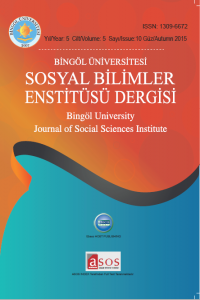Abstract
In Turkish, in order to divide a word into syllables, it is necessary to consider the vowels. As first two sounds of such words as “kral(king), trafik(traffic), spor(sport)…” are consonants, it is difficult to divide them into syllables for primary school students. Therefore a vowel is needed to put between the first two vowels. It is plausible to treat these foreign words which introduced into Turkish and counted as Turkish like other Turkish words and such words should be written aspronounced. Moreover, Turkish is one of these languages which are written as they are pronounced. For instance, we write such words as “clup, faide(use), renk(colour), direksiyon(direction)…” in the same manner as they are pronounced. In the words such as “laboratuar(laboratory), pisuar” in which two vowels occur jointly they are written as “laboratuar, pisuvar”. Additionally, it is a requirement to standardize the usage of such words which is arguably written as adjacently or detached or written with a capital letter or otherwise.
References
- ERGİN, Muharrem; Türk Dil Bilgisi, Boğaziçi Yay.,İstanbul, 1980.
- KARAALİOĞLU, Seyit Kemal; Sözlü-Yazılı Kompozisyon Konuşmak ve Yazmak Sanatı, İnkılap ve Aka Kitapevleri Yay., İstanbul, 1963.
- TANSEL, Fevziye Abdullah; İyi ve Doğru Yazma Usulleri, Kubbealtı Neşriyatı, İstanbul, 1978.
- TUNA, Osman Nedim; Dilbilgisi Fonetik-Morfoloji, İnönü Üniversitesi Yay. Malatya, 1987.
- Türkçe Sözlük I-II, TDK Yay., Ankara, 1988.
- Türk Dili Araştırmaları Yıllığı Belleten, TDK Yay., Ankara, 1964.
- Yazım Kılavuzu, TDK Yay., Ankara, 2005
Abstract
Türkçede bir kelimeyi hecelerine ayırmak için, ünlüleri göz önünde bulundurmak gerekmektedir. “Kral, trafik, spor…” gibi sözcüklerin ilk iki sesi ünsüz olduğundan, bunları hecelere bölmek ilkokul öğrencileri için zordur. Bunun için bu gibi kelimelerin ilk iki ünsüzü arasına bir ünlü koymak gereklidir. Türkçeye girmiş ve artık Türkçenin malı gibi olmuş diğer yabancı sözcükleri de, Türkçedeki söyleyişlerine göre yazmak daha isabetli olacaktır. Çünkü Türkçe, okunduğu gibi yazılan dillerden biridir. Nitekim “clup, faide, reng, direksion…” gibi kelimeler, telaffuz edildikleri “kulüp, fayda, renk, direksiyon” biçimlerinde yazılmaktadır. İki ünlünün yan yana geldiği “laboratuar, pisuar…” gibi kelimeler de, artık “laboratuar, pisuvar” şekillerinde kullanılmaktadır. Ayrıca bazı kelime gruplarındaki bitişikayrı yazım ve büyük harf-küçük harf kullanımını tam bir istikrara kavuşturmak gerekmektedir.
References
- ERGİN, Muharrem; Türk Dil Bilgisi, Boğaziçi Yay.,İstanbul, 1980.
- KARAALİOĞLU, Seyit Kemal; Sözlü-Yazılı Kompozisyon Konuşmak ve Yazmak Sanatı, İnkılap ve Aka Kitapevleri Yay., İstanbul, 1963.
- TANSEL, Fevziye Abdullah; İyi ve Doğru Yazma Usulleri, Kubbealtı Neşriyatı, İstanbul, 1978.
- TUNA, Osman Nedim; Dilbilgisi Fonetik-Morfoloji, İnönü Üniversitesi Yay. Malatya, 1987.
- Türkçe Sözlük I-II, TDK Yay., Ankara, 1988.
- Türk Dili Araştırmaları Yıllığı Belleten, TDK Yay., Ankara, 1964.
- Yazım Kılavuzu, TDK Yay., Ankara, 2005
Details
| Primary Language | Turkish |
|---|---|
| Journal Section | Articles |
| Authors | |
| Publication Date | October 15, 2015 |
| Published in Issue | Year 2015Volume: 5 Issue: 10 |



